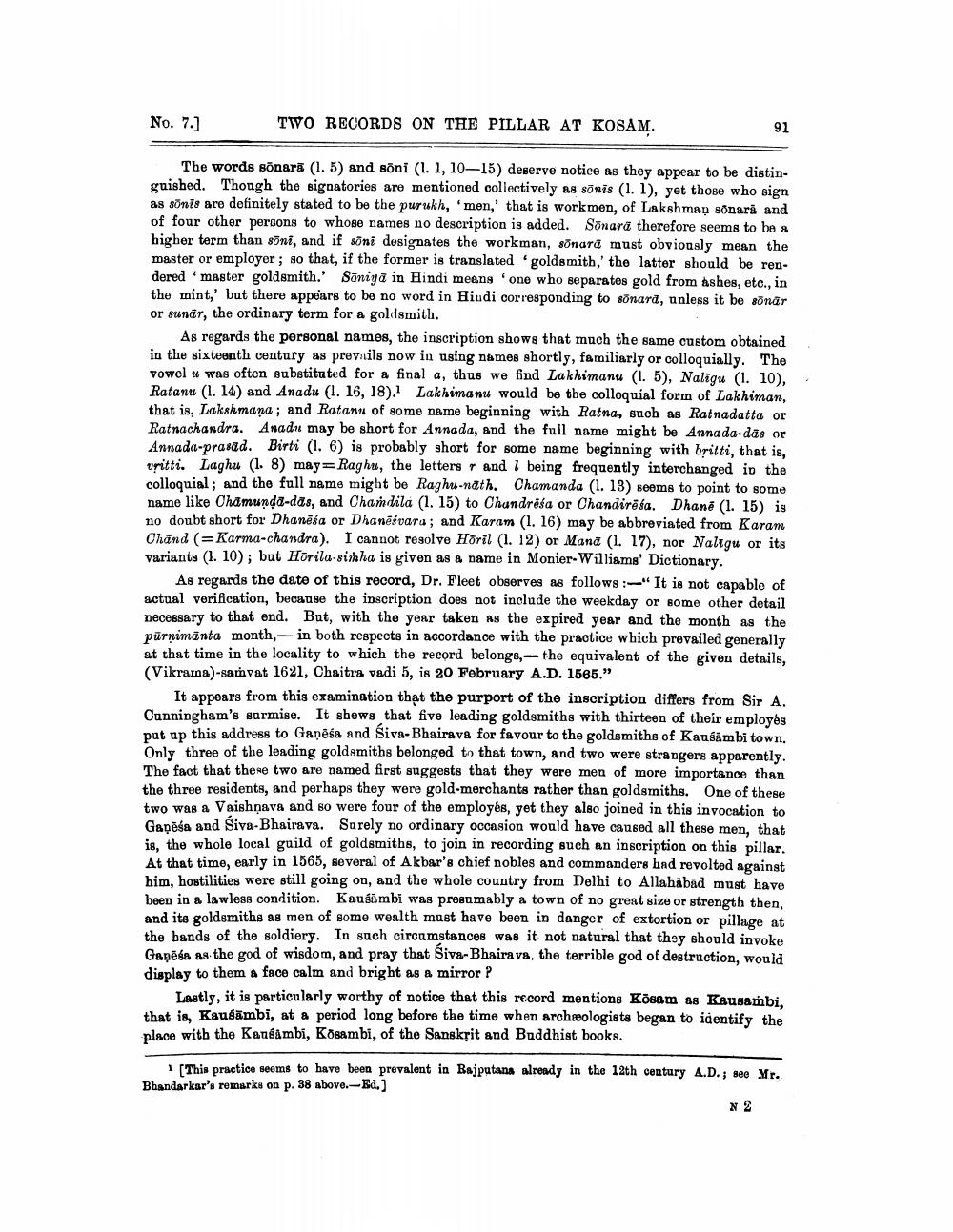________________
No. 7.]
TWO RECORDS ON THE PILLAR AT KOSAM.
The words sõnara (1. 5) and soni (1. 1, 10-15) deserve notice as they appear to be distinguished. Though the signatories are mentioned collectively as sõnis (1.1), yet those who sign as sõnis are definitely stated to be the purukh, 'men,' that is workmen, of Lakshman sonara and of four other persons to whose names no description is added. Sõnara therefore seems to be a higher term than söni, and if soni designates the workman, sõnara must obviously mean the master or employer; so that, if the former is translated 'goldsmith,' the latter should be rendered 'master goldsmith.' Sõniya in Hindi means one who separates gold from ashes, etc., in the mint, but there appears to be no word in Hiudi corresponding to sõnara, unless it be sonar or sunar, the ordinary term for a goldsmith.
As regards the personal names, the inscription shows that much the same custom obtained in the sixteenth century as prev tils now in using names shortly, familiarly or colloquially. The vowel u was often substituted for a final a, thus we find Lakhimanu (1. 5), Naligu (1. 10), Ratanu (1. 14) and Anadu (1. 16, 18). Lakhimaru would be the colloquial form of Lakhiman, that is, Lakshmana; and Ratann of some name beginning with Ratna, such as Ratnadatta or Ratnachandra. Anadu may be short for Annada, and the full name might be Annada-das or Annada-prasad. Birti (1. 6) is probably short for some name beginning with britti, that is, vritti. Laghu (1. 8) may=Raghu, the letters and l being frequently interchanged in the colloquial; and the full name might be Raghu-nath. Chamanda (1. 13) seems to point to some name like Chamunda-das, and Chandila (1. 15) to Chundrésa or Chandirēša. Dhanë (1. 15) is no doubt short for Dhanēsa or Dhanēsvara; and Karam (1. 16) may be abbreviated from Karam Chand (=Karma-chandra). I cannot resolve Höril (1.12) or Manā (1. 17), nor Naligu or its variants (1. 10); but Hörila-simha is given as & dame in Monier-Williams' Dictionary.
As regards the date of this record, Dr. Fleet observes as follows:-" It is not capable of actual verification, because the inscription does not include the weekday or some other detail necessary to that end. But, with the year taken as the expired year and the month as the pürnimänta month,-in both respects in accordance with the practice which prevailed generally at that time in the locality to which the record belongs - the equivalent of the given details, (Vikrama)-satvat 1621, Chaitra vadi 5, is 20 February A.D. 1565."
It appears from this examination that the purport of the inscription differs from Sir A. Cunningham's surmise. It shews that five leading goldsmiths with thirteen of their employés pat no this address to Gaņēśa and Siva-Bhairava for favour to the goldsmiths of Kansambi town. Only three of the leading goldsmiths belonged to that town, and two were strangers apparently. The fact that these two are named first suggests that they were men of more importance than the three residents, and perhaps they were gold-merchants rather than goldsmiths. One of these two was a Vaishnava and so were four of the employés, yet they also joined in this invocation to Gadēša and Siva-Bhairava. Sarely no ordinary occasion would have caused all these men, that is, the whole local guild of goldsmiths, to join in recording such an inscription on this pillar. At that time, early in 1565, several of Akbar's chief nobles and commanders had revolted against him, hostilities were still going on, and the whole country from Delhi to Allahabad must have been in a lawless condition. Kausā mbi was presumably a town of no great size or strength then, and its goldsmiths ag men of some wealth must have been in danger of extortion or pillage at the bands of the soldiery. In such circumstances was it not natural that they should invoke Ganēsa as the god of wisdom, and pray that Siva-Bhairava, the terrible god of destruction, would display to them a face calm and bright as a mirror ?
Lastly, it is particularly worthy of notice that this record mentions Kogam as Kausarbi. that is, Kausämbi, at a period long before the time when archæologists began to identify the place with the Kansambi, Kosambi, of the Sanskrit and Buddhist books.
This practice seems to have been prevalent in Bajputans already in the 12th century A.D.; see Mr. Bhandarkar's remarks on p. 38 above.-Ed.)




